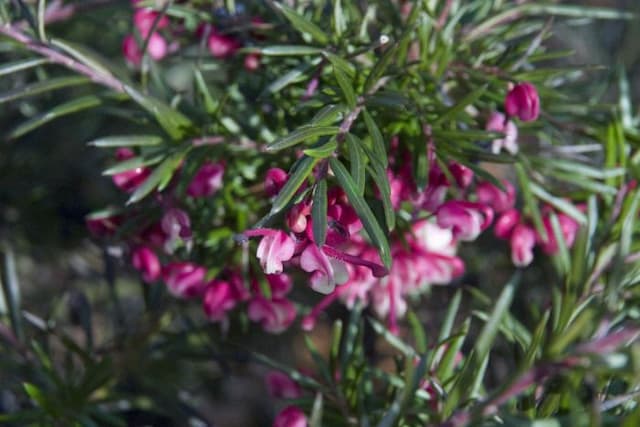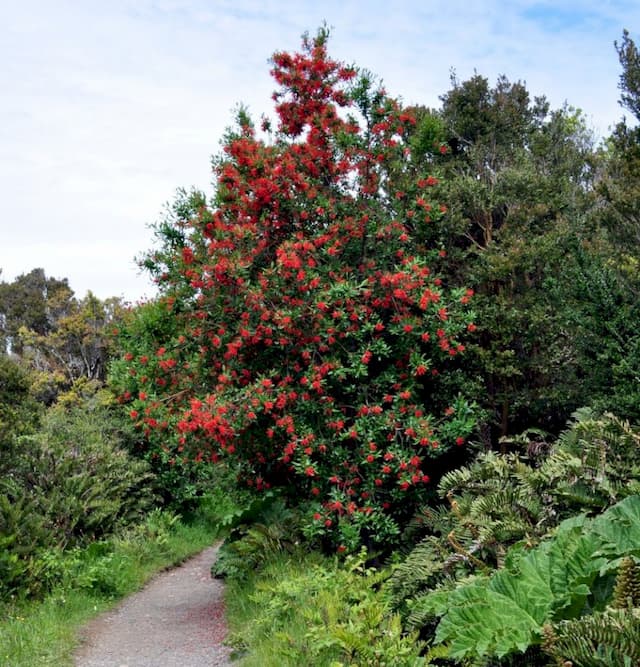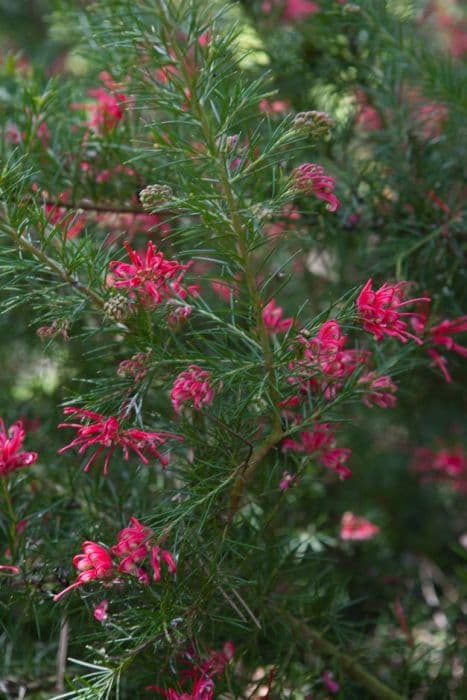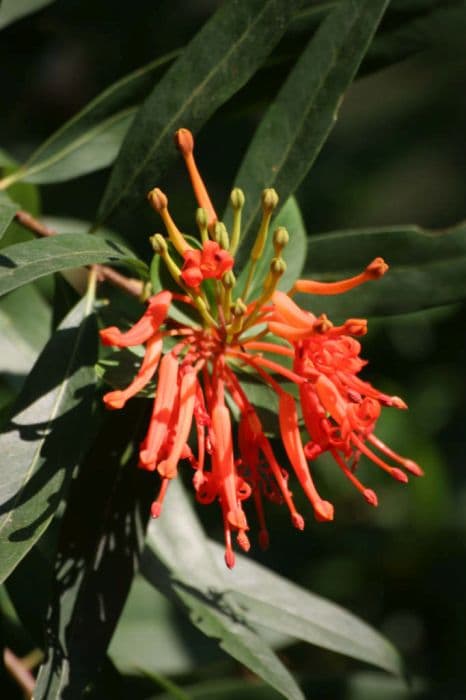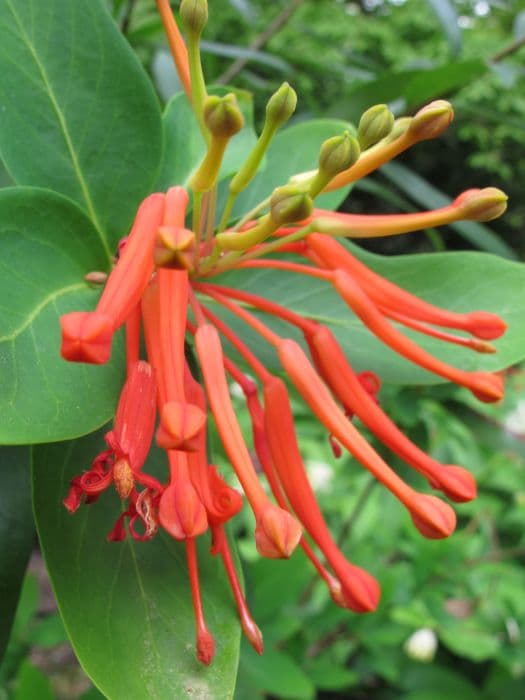Rosemary Grevillea Grevillea rosmarinifolia

ABOUT
Grevillea rosmarinifolia, commonly known as Rosemary Grevillea, is a plant that bears a remarkable resemblance to the herb rosemary, hence its name. Its appearance is characterized by its needle-like leaves, which are glossy and bear a rich green color. These leaves are reminiscent of rosemary both in shape and texture, typically linear and small, with a firm and pointy tip, creating an overall fine and elegant foliage. The Rosemary Grevillea is adorned with striking flowers that add a beautiful contrast to its dense greenery. The blooms are unique, with long, curved styles that emerge from the curled petals, giving them a spider-like appearance. These flowers usually bloom in clusters, gracing the plant with shades of red, pink, or cream, depending on the variety. Their intricate form is not only a treat for the eyes but also attracts a host of pollinators, including birds and bees. The plant has a bushy habit, with branches that can spread out gracefully, giving it a soft, mounded silhouette. Its stems can be somewhat rigid, contributing to the overall structural look of the plant. The texture, color, and shape of both leaves and flowers make the Rosemary Grevillea a popular choice for adding visual interest to gardens and landscapes without overwhelming the space.
About this plant
 Names
NamesFamily
Proteaceae
Synonyms
Rosemary Grevillea, Rosemary-leaf Grevillea, Spider Flower
Common names
Grevillea rosmarinifolia var. rosmarinifolia, Grevillea rosmarinifolia subsp. rosmarinifolia, Grevillea lavandulacea.
 Toxicity
ToxicityTo humans
The plant known as Rosemary Grevillea generally is not considered highly toxic to humans. However, some people might experience skin irritation or allergic reactions upon contact with its foliage or flowers due to the presence of needle-like leaves that can cause physical irritation or as a result of sensitivity to its natural oils. Ingestion is not common, but if parts of the plant are ingested, it could potentially lead to gastrointestinal upset, including nausea, vomiting, or diarrhea. The most common consequence of interacting with this plant is dermal irritation; significant poisoning from ingestion is rare.
To pets
Rosemary Grevillea is similarly not well-known for being highly toxic to pets. However, as with humans, the plant can potentially cause skin irritation for pets, particularly those with sensitive skin. If ingested, the plant could cause mild gastrointestinal upset in some pets, leading to symptoms such as vomiting or diarrhea. It is generally recommended to prevent pets from chewing on or ingesting this plant. If a pet does consume significant quantities, it is advisable to monitor them for any adverse reactions and consult a veterinarian if any worrying symptoms arise.
 Characteristics
CharacteristicsLife cycle
Perennials
Foliage type
Evergreen
Color of leaves
Green
Flower color
Red
Height
3-6 feet (0.91-1.83 meters)
Spread
3-6 feet (0.91-1.83 meters)
Plant type
Shrub
Hardiness zones
8
Native area
Australia
Benefits
 General Benefits
General Benefits- Attracts Wildlife: Grevillea rosmarinifolia, commonly known as Rosemary Grevillea, is known for attracting birds, bees, and beneficial insects which aid in pollination and pest control in the garden.
- Drought Tolerance: The Rosemary Grevillea is highly drought-resistant once established, making it an excellent choice for water-wise landscaping and gardens in arid climates.
- Low Maintenance: This plant is generally low maintenance, requiring minimal care once it has settled into its environment, which makes it suitable for busy gardeners.
- Ornamental Value: With its needle-like leaves and attractive red or pink flowers, it adds aesthetic appeal to the landscape throughout the year.
- Erosion Control: Its root system helps stabilize the soil, making it useful for controlling erosion on slopes and banks.
- Adaptability: Rosemary Grevillea can adapt to a variety of soil types, though it prefers well-drained soils, making it versatile for different garden settings.
- Wildfire Resistance: The plant is also recognized for being somewhat fire retardant, which can be beneficial in fire-prone areas.
- Habitat Creation: It can serve as an excellent habitat and protection for small wildlife within a garden ecosystem.
 Medical Properties
Medical PropertiesThis plant is not used for medical purposes.
 Air-purifying Qualities
Air-purifying QualitiesThis plant is not specifically known for air purifying qualities.
 Other Uses
Other Uses- Garden Sculpting: Grevillea rosmarinifolia can be pruned and shaped into garden sculptures or topiaries, providing unique and artistic forms in the landscape.
- Floral Arrangements: The flowers and foliage of the Rosemary Grevillea can add an exotic touch to floral arrangements and bouquets.
- Erosion Control: Due to its dense growth, the plant can be used on slopes to help prevent soil erosion.
- Bee Attraction: The blooms of the Rosemary Grevillea are rich in nectar, making them ideal for supporting bee populations by providing a food source.
- Bird Habitat: The dense foliage provides excellent shelter and nesting sites for various bird species.
- Educational Resource: The plant can be used in schools and educational centers to teach about native flora and the importance of plant-pollinator relationships.
- Drought Tolerant Garden Example: Rosemary Grevillea serves as an exemplary plant for xeriscaping, demonstrating how gardens can be beautiful and low-water.
- Privacy Screening: When planted in a row, they can create a natural privacy screen due to their dense growth habit.
- Cultural Significance: Indigenous Australians may use the plant as a tool to discuss the significance of native flora in their culture and ecosystems.
- Butterfly Garden Component: The flowers can attract butterflies, enhancing the biodiversity and beauty of butterfly gardens.
Interesting Facts
 Feng Shui
Feng ShuiThe Rosemary Grevillea is not used in Feng Shui practice.
 Zodiac Sign Compitability
Zodiac Sign CompitabilityThe Rosemary Grevillea is not used in astrology practice.
 Plant Symbolism
Plant Symbolism- Resilience: Grevillea rosmarinifolia, commonly known as Rosemary Grevillea, is renowned for its hardiness and ability to withstand tough environmental conditions, making it symbolic of resilience and endurance.
- Adaptability: This plant can adapt to a variety of soil types and climates, symbolizing flexibility and the ability to thrive in diverse situations.
- Protective Qualities: The needle-like foliage of the Rosemary Grevillea can act as a deterrent for animals and can symbolize protection and a safe haven.
- Australian Natural Beauty: As a native Australian plant, the Rosemary Grevillea represents the unique beauty and biodiversity of the Australian landscape.
 Water
WaterRosemary grevillea prefers moderate watering, where the soil is allowed to dry out slightly between watering sessions. Water the plant deeply, ensuring moisture reaches the root zone. In general, watering once a week with approximately 1 to 1.5 gallons of water should suffice, although this may need to increase to twice a week during the hotter months. It's important not to overwater, as this can lead to root rot. Always check the soil moisture before watering.
 Light
LightRosemary grevillea thrives in full sun to partial shade conditions. It's best placed in a spot where it can receive at least 6 hours of direct sunlight daily. The plant can tolerate some light shade, especially during the hottest part of the day, but too much shade may result in reduced flowering and leggy growth.
 Temperature
TemperatureRosemary grevillea is hardy and can survive in temperatures as low as 20 to 25 degrees Fahrenheit, albeit it may sustain some damage. The plant prefers a temperature range between 50 and 90 degrees Fahrenheit. If temperatures rise above 100 degrees Fahrenheit, ensure the plant has adequate water and some protection from the most intense heat.
 Pruning
PruningPruning rosemary grevillea helps to maintain its shape and encourage bushier growth. It's best pruned in the late winter or early spring before new growth begins. The plant can be pruned lightly throughout the year to remove dead or damaged branches. Typically, annual pruning is sufficient for keeping the plant in good condition.
 Cleaning
CleaningAs needed
 Soil
SoilRosemary grevillea thrives in well-draining, sandy to loamy soil with a slightly acidic to neutral pH range of 6.0 to 7.0. A mixture of equal parts sand, loam, and peat with some gravel for added drainage is ideal.
 Repotting
RepottingRosemary grevillea should be repotted every 2 to 3 years or when roots become pot-bound. Young plants may require more frequent repotting.
 Humidity & Misting
Humidity & MistingRosemary grevillea prefers a moderate to low humidity environment.
 Suitable locations
Suitable locationsIndoor
Place in bright, indirect light; ensure good air circulation.
Outdoor
Choose sunny spot, shield from harsh winds, well-draining soil.
Hardiness zone
9-11 USDA.
 Life cycle
Life cycleGrevillea rosmarinifolia, commonly known as Rosemary Grevillea, starts its life as a seed, which upon germination, develops into a seedling with a primary root and shoots. As it grows, the plant transitions into a juvenile phase, characterized by foliage growth and establishment of a strong root system. This is followed by the mature phase, where the plant reaches full size, produces needle-like leaves, and begins to flower, showing off its distinctive red, pink or yellow inflorescences, typically from winter to spring. These flowers are rich in nectar and attract a variety of pollinators including birds and bees, leading to cross-pollination. After pollination, the flowers develop into fruit, which are follicles containing seeds that, when mature, are released into the environment to start a new generation. Rosemary Grevillea is a perennial plant, and this cycle of growth, flowering, and seed production can occur yearly throughout the plant’s lifespan, which can be several decades under optimal conditions.
 Propogation
PropogationPropogation time
Spring-Early Summer
The most popular method for propagating the Grevillea rosmarinifolia, commonly known as the Rosemary Grevillea, is through semi-hardwood cuttings. This approach is usually done in late summer. To propagate, one would take cuttings of about 4 to 6 inches (approximately 10 to 15 cm) in length, ensuring each cutting has a few leaves. Next, the lower leaves are removed, and the base of the cutting is dipped into a rooting hormone powder to encourage root development. The prepared cuttings are then inserted into a pot filled with a well-draining propagation medium, such as a mix of peat and perlite. The pot should be kept in a warm, sheltered location with indirect light and maintained moist until the cuttings have rooted, which tends to take several weeks. It's important to avoid direct sunlight to prevent the delicate cuttings from drying out.
